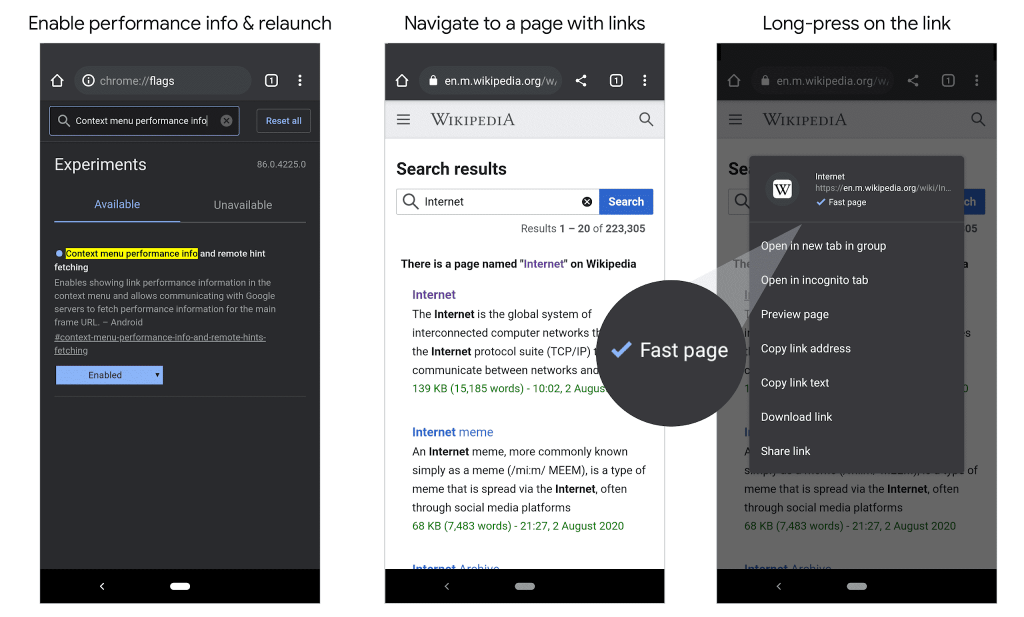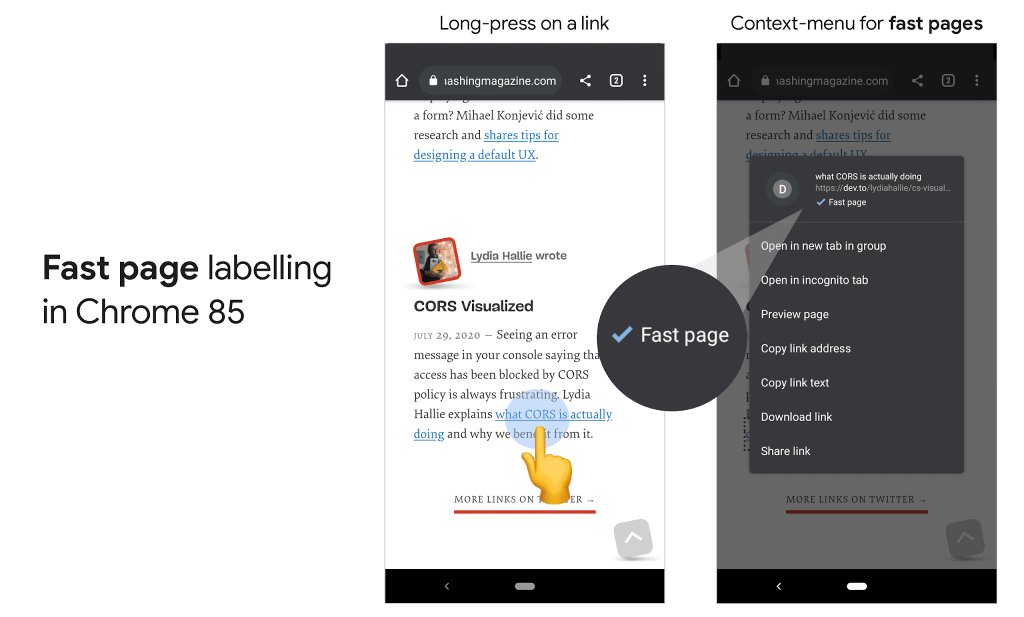Chrome to Highlight Fast-Loading Web Pages on Mobile Devices
August 26, 2020
Article Overview
10min read
Google Chrome has announced an update that will highlight certain pages with a “fast page” label via the link context menu on Chrome for Android. As Google Chrome on Android is one of the fastest browsers available for mobile users, Google is constantly trying to provide users with a fast, responsive and delightful browsing experience. With this latest update rolling out in Chrome 85 Beta, Google hopes to help users identify great experiences as they browse. However, Google’s definition of providing a good user experience means meeting or exceeding all Core Web Vitals benchmarks.
‘Fast Page’ Labelling
Historically, Google Chrome and the web development community have worked towards providing good user experiences and have also successfully encouraged the adoption of best-practices such as HTTPS in Chrome’s UI. Chrome’s latest feature “fast label” is simple and will assist users in identifying links on sites which will be fast.
The ‘fast page’ label can be activated through an update to Google Chrome. However, the pages are selected based on whether they meet or exceed the thresholds for Core Web Vitals. When the benchmarks are met, pages that are considered to be “high quality” by Google will have a “fast page” label when the context menu (long-press) is brought up within the Android Chrome mobile browser.
Chrome’s labelling feature uses Google’s Core Web Vitals program which quantifies various metrics in a user’s browsing experience. That is, the Core Web Vitals report displays how well a web page performs based on field data or real-world data. This gives users the ability to ensure whether the page they’re about to visit is fast, responsive, stable and secure.
For instance, when the URL, or other URLs like it, has been previously fast for other users, then Chrome will display the new badge. If a page does not have enough past data, then Google will evaluate it based on the history of the website’s host. This feature is currently rolling out to the beta version of Chrome 85 on Android, although Google lets the users to test labeling now with the following simple steps:
1. Navigate to chrome://flags/.
2. Enable “Context menu performance info and remote hint fetching”.
Once it rolls out for everyone, users will start to witness the “fast page” label when using Chrome in Lite mode or when turning on ‘Make Searches and Browsing Better’.
3. Next, navigate to any qualifying fast page and long-press on any link.

However, currently, the feature appears to be exclusive to the Android users — in fact, there hasn’t been any word on future support for iOS Chrome users.
Core Web Vitals Assessments
It’s a fact that, if this new update were to roll out today, less than 15% of sites on the web would only earn the “fast page” label. This is because, according to data from a recent study, only a decidedly small percentage of websites are optimized well enough to pass a Core Web Vitals assessment within PageSpeed Insights.
The report uses 3 metrics:
1. LCF or Large Contentful Paint.
2. FID or First Input Delay.
3. CLS or Cumulative Layout Shift.
LCF is the time taken for a web page’s main content to load. The ideal measurement is 2.5 seconds or more. FID is a measurement of the time it takes for a page to become interactive, with the ideal period being below 100 milliseconds. Meanwhile, CLS is the measurement of visual stability, which is the shifting of page elements while it is downloading.
Despite millions of websites in existence, many websites meet the benchmarks for one or two of the web vitals, but very few websites meet all three web vitals. With the new update, Chrome will add the ‘fast page’ tag to those web pages that meet the LCF, FID and CLS benchmarks. This feature is especially useful for users whose internet speed is mediocre or for those who just can’t be bothered visiting slow pages.
Foreseeing that optimizing for the Core Web Vitals may require some investments in improving page quality, Google has also updated its developer tools to surface information and recommendations. Lighthouse, DevTools, PageSpeed Insights, and Search Console team helped Google provide a dedicated Core Web Vitals report. These tools help developers obtain “fast page” classification for their web pages.
With the ‘fast page’ feature currently in beta mode and the forthcoming Google update – will turn Core Web Vitals into ranking signals – only being made available in 2021, site owners have enough time to optimize their sites and get them to qualify as fast pages.


 +971 52 312 2506
+971 52 312 2506





